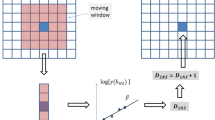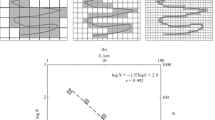Abstract
This paper is concerned with the application of fractal analysis to understand the structure of water-worked gravel-bed river surfaces. High resolution digital elevation models, acquired using digital photogrammetric methods, allowed the application of two-dimensional fractal methods. Previous gravel-bed river studies have been based upon sampled profiles and hence one-dimensional fractal characterisation. After basic testing that bed elevation increments are Gaussian, the paper uses two-dimensional variogram surfaces to derive directionally dependent estimates of fractal dimension. The results identify mixed fractal behavior with two characteristic fractal bands, one associated with the subgrain scale and one associated with the grain scale. The subgrain scale characteristics were isotropic and sensitive to decisions made during the data collection process. Thus, it was difficult to differentiate whether these characteristics were real facets of the surfaces studied. The second band was anisotropic and not sensitive to data collection issues. Fractal dimensions were greater in the downstream direction than in other directions suggesting that the effects of water working are to alter the level of surface organisation, by increasing surface irregularity and hence roughness. This is an important observation as it means that water-worked surfaces may have a distinct anisotropic signal, revealed when using a fractal type analysis.
Similar content being viewed by others
REFERENCES
Andrle, R., and Abrahams, A. D., 1989, Fractal techniques and the surface roughness of talus slopes: Earth Surface Processes and Landforms, v. 14, p. 197–209.
Armstrong, M., 1986, Common problems seen in variograms: Math. Geology, v. 16, p. 305–313.
Avnir, D., Biham, O., Lidar, D., and Malcai, O., 1998, Is the geometry of nature fractal?: Science, v. 279, p. 39–40.
Biham, O., Malcai, O., Lidar, D., and Avnir, D., 1998, Reply to the discussion of ‘Is the geometry of nature fractal?’: Science, v. 279, p. 785–786.
Bray, D. I., 1982, Flow resistance in gravel-bed rivers, in Hey, R. D., Bathurst, J. C., and Thorne, C. R., eds., Gravel-bed rivers: Chichester, Wiley, p. 109–133.
Burrough, P., 1981, Fractal dimensions of landscapes and other environmental data: Nature, v. 294, p. 240–242.
Burrough, P. A., 1983a, Multi-scale sources of spatial variation in soil. I. The application of fractal concepts to nested levels of soil variation: Journal of Soil Science, v. 34, p. 577–597.
Burrough, P. A., 1983b, Multi-scale sources of spatial variation in soil. I. A non-Brownian fractal model and its application in soil survey: Journal of Soil Science, v. 34, p. 599–620.
Butler, J. B., 1999, High resolution photogrammetric monitoring and analysis of the structure of gravel-bed river surfaces: unpubl. soctoral dissertation, University of Cambridge, 311 p.
Butler, J. B., Lane, S. N., and Chandler, J. H., 1998, Assessment of DEM quality for characterising surface roughness using close range digital photogrammetry: Photogrammetric Record, v. 16, p. 271–291.
Chase, C. G., 1992, Fluvial landsculpting and the fractal dimension of topography: Geomorphology, v. 5, p. 39–57.
Clifford, N. J., Robert, A., and Richards, K. S., 1992, Estimation of flow resistance in gravel-bedded rivers: A physical explanation of the multiplier of roughness length: Earth Surface Processes and Landforms, v. 17, p. 111–126.
Cressie, N., and Hawkins, D. M., 1980, Robust estimation of the variogram: I: Math. Geology, v. 12, p. 115–124.
Culling, W. E. H., 1986, On Hurst phenomena in the landscape: Transactions of the Japanese Geomorphological Union, v. 7, p. 221–243.
Culling, W. E. H., and Datko, M. 1987, The fractal geometry of the soil-covered landscape: Earth Surface Processes and Landforms, v. 12, p. 369–385.
David, M., 1977, Geostatistical ore reserve estimation: Elsevier, Amsterdam, 364 p.
Furbish, D. J., 1987, Conditions for geometric similarity of coarse stream-bed roughness: Math. Geology, v. 19, p. 291–307.
Gomez, B., 1993, Roughness of stable, armoured gravel beds: Water Resources Research, v. 29, p. 3631–3642.
Goodchild, M. F., 1980, Fractals and the accuracy of geographical measures: Math. Geology, v. 12, p. 85–98.
Goodchild, M. F., and Mark, D. M., 1987, The fractal nature of geomorphic phenomenon: Annals of the Association of American Geographers, v. 77, p. 265–278.
Hassan, M. A., and Reid, I., 1990, The influence of microform bed roughness elements on flow and sediment transport in gravel-bed rivers: Earth Surface Processes and Landforms, v. 8, p. 39–50.
Huang, J., and Turcotte, D., 1990, Fractal mapping of digitised images: Application to the topography of Arizona and comparisons with synthetic images: Journal of Geophysical Research, v. 94, p. 7491–7495.
Jakeman, A. J., Beck, M. B., and McAleer, M. J., eds., 1993, Modelling change in environmental systems: Wiley & Sons, Chichester, p. 584.
Journel, A. G., and Huijbregts, C. J., 1978, Mining geostatistics: Academic Press, San Diego, 600 p.
Kent, C., and Wong, J., 1982, An index of littoral zone complexity and its measurement: Canadian Journal of Fisheries and Aquatic Science, v. 39, p. 847–853.
Kirchner, J. W., Dietrich, W. E., Iseya, F., and Ikeda, H., 1990, The variability of critical shear stress, friction angle, and grain protrusion in water-worked sediments: Sedimentology, v. 37, p. 647–672.
Klinkenberg, B., 1992, Fractals and morphometric measures: Is there a relationship?: Geomorphology, v. 5, p. 5–20.
Klinkenberg, B., 1994, A review of methods used to determine the fractal dimension of linear features: Math. Geology, v. 26, p. 23–46.
Klinkenberg, B., and Clarke, K., 1992, Exploring the fractal mountains, in Palaz, I., and Sengupta, S., eds., Automated pattern analysis in petroleum exploration: Springer-Verlag, New York, p. 201–212.
Klinkenberg, B., and Goodchild, M. F., 1992,The fractal properties of topography: A comparison of methods: Earth Surface Processes and Landforms, v. 17, p. 217–234.
Leopold, L. B., Wolman, M. G., and Miller, J. P., 1964, Fluvial processes in geomorphology: W. H. Freeman, San Francisco, 522 p.
Malinverno, A., 1989, Testing linear models of sea-floor topography: Pure and Applied Geophysics, v. 131, p. 139–155.
Mandelbrot, B., 1977, Fractals: Form, chance and dimension: W. H. Freeman and Co., San Francisco, 365 p.
Mandelbrot, B., 1982, The fractal geometry of nature: Freeman, New York, 460 p.
Mandelbrot, B., 1998, A discussion of ‘Is the geometry of nature fractal?’: Science, v. 279, p. 783–785.
Mandlebrot, B. B., and Van Ness, J. W., 1968, Fractional Brownian motions, fractional noises and applications: SIAM Review, v. 10, p. 422–437.
Mark, D. M., and Aronson, P. B., 1984, Scale dependent fractal dimensions of topographic surfaces: An empirical investigation with applications in geomorphology and computer mapping: Math. Geology, v. 16, p. 671–683.
Matheron, G., 1965, Les variables regionalisees et leur estimation: Masson et Cie, Paris.
McBratney, A. B., and Webster, R., 1986, Choosing functions for semi-variograms of soil properties and fitting them to sampling estimates: Jour. Soil Science, v. 37, p. 617–639.
Milne, B. T., 1991, Lessons from applying fractal models to landscape patterns, in Turner, M. G., and Gardner, R. H., eds., Quantitative methods in landscape ecology: The analysis and interpretation of landscape heterogeneity: Springer, New York, p. 199–235.
Nakano, T., 1983, A “fractal” study of some rias coastlines in Japan: Annual Report of the Institute of Geosciences, University of Tsukuba, v. 9, p. 75–80.
Nakano, T., 1984, A systematics of “transient fractals” of rias coastline; an example of rias coast from Kamaishi to Shizugawa: Annual Report of the Institute of Geosciences, University of Tsukuba, v. 10, p. 66–68.
Nikora, V. L., Goring, D. G., and Biggs, B. J. F., 1998, On gravel-bed roughness characterisation: Water Resources Research, v. 34, p. 517–527.
Oliver, M. A., and Webster, R., 1986, Semi-variogram for modelling the spatial pattern of land form and soil properties: Earth Surface Processes and Landforms, v. 11, p. 491–504.
Orford, J. D., and Whalley, W. B., 1983, The use of fractal dimension to quantify the morphology of irregularly-shaped particles: Sedimentology, v. 30, p. 655–668.
Ouchi, S., and Matsushita, M., 1992, Measurement of self-affinity on surfaces as a trial application of fractal geometry to landform analysis: Geomorphology, v. 5, p. 115–130.
Pfeifer, P., 1984, Fractal dimension as a working tool for surface-roughness problems: Applications of Surface Science, v. 18, p. 146–164.
Pfeifer, P., 1998, A discussion of ‘Is the geometry of nature fractal?’: Science, v. 279, p. 785.
Polidori, L., Chorowicz, J. and Guillande, R., 1991, Description of terrain as a fractal surface, and application to digital elevation model quality assessment: Photogrammetric Engineering and Remote Sensing, v. 57, p. 1329–1332.
Rammal, R., 1984, Random walk statistics on fractal structures: Journal of Statistical Physics, v. 36, p. 47.
Robert, A., 1988, Statistical analysis of sediment bed profiles in alluvial channels: Math. Geology, v. 20, p. 205–225.
Robert, A., 1991, Fractal properties of simulated bed profiles in coarse-grained channels: Math. Geology, v. 23, p. 367–382.
Robert, A., and Richards, K. S., 1988, On the modelling of sand bedforms using the semi-variogram: Earth Surface Processes and Landforms, v. 13, p. 459–473.
Roy, A., Gravel, G., and Gauthier, C., 1987, Measuring the dimension of surfaces: A review and appraisal of different methods: Proceedings Auto-Carto, v. 8, p. 68–77.
Russ, J. C., 1994, Fractal surfaces: Plenum Press, London, p. 309.
Schumm, S. A., and Lichty, R. W., 1965, Time, space and causality in geomorphology: American Journal of Science, v. 263, p. 110–119.
Shelberg, M. C., Moellering, H., and Lam, N. S., 1983, Measuring the fractal dimensions of surfaces: Proceedings Auto-Carto, v. 6, p. 319–328.
Strickler, D., 1923, Beiträge zur fragen der Geschwundigkeitsformel und der Rauhigkeitszahlen für Ströme, Kanale und Geschlossene Leitungen: Mitteilung der Eidgenossenschaft Amtes für Wasserwirtschaft Nr. 16, Bern, Switzerland, 16 p.
Suzuki, M., 1984, Finite-size scaling for transient similarity and fractals: Progress in Theoretical Physics, v. 71, p. 1397–1400.
Weissel, J. K., Pratson, L. F., and Malinverno, A., 1994, The length-scaling properties of topography: Journal of Geophysical Research, v. 99, p. 13997–14012.
Xia, Z., 1993, The use and limitations of fractal geometry in digital terrain modelling: Unpubl. doctonal dissertation, City University of New York.
Xu, T., Moore, I. D., and Gallant, J. C., 1993, Fractals, fractal dimensions and landscapes-a review: Geomorphology, v. 8, p. 245–262.
Author information
Authors and Affiliations
Rights and permissions
About this article
Cite this article
Butler, J.B., Lane, S.N. & Chandler, J.H. Characterization of the Structure of River-Bed Gravels Using Two-Dimensional Fractal Analysis. Mathematical Geology 33, 301–330 (2001). https://doi.org/10.1023/A:1007686206695
Issue Date:
DOI: https://doi.org/10.1023/A:1007686206695




